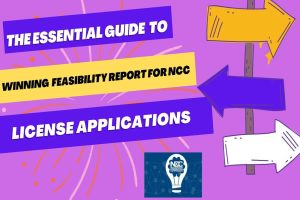The Essential Guide to Writing a Winning Feasibility Report for NCC License Applications
Are you tired of submitting NCC license applications that fall flat? 🤔 Imagine having a secret weapon that could skyrocket your chances of success. That’s exactly what a well-crafted feasibility report can do for you. In today’s competitive telecommunications landscape, standing out from the crowd is more crucial than ever.
But here’s the problem: many applicants underestimate the power of a strong feasibility report, often rushing through this critical step. The result? Rejected applications, wasted time, and missed opportunities. Don’t let this be your story. It’s time to turn the tables and give your NCC license application the edge it deserves.
In this essential guide, we’ll walk you through the ins and outs of creating a winning feasibility report. From understanding the application process to leveraging data visualization for maximum impact, we’ve got you covered. Get ready to transform your approach and learn how to craft a report that not only meets requirements but exceeds expectations. Let’s dive in and explore the key components that will set your application apart from the rest.
Understanding the NCC License Application Process

Key requirements for NCC licenses
To obtain an NCC (Nigerian Communications Commission) license, applicants must meet several crucial requirements:
-
Legal Entity: Must be a registered company in Nigeria
-
Technical Expertise: Demonstrate capability to provide proposed services
-
Financial Capacity: Show adequate funding and financial projections
-
Operational Plan: Present a detailed business and network rollout plan
-
Compliance: Adhere to NCC regulations and industry standards
| Requirement | Description |
|---|---|
| Legal Entity | Registered Nigerian company |
| Technical Expertise | Proven capability in proposed services |
| Financial Capacity | Adequate funding and projections |
| Operational Plan | Detailed business and network strategy |
| Compliance | Adherence to NCC regulations |
Types of licenses available
The NCC offers various license categories to cater to different telecommunications services:
-
Individual Licenses:
-
Unified Access Service License (UASL)
-
International Gateway License
-
National Long-Distance Operator License
-
-
Class Licenses:
-
Internet Service Provider (ISP) License
-
Value Added Service (VAS) Provider License
-
-
Spectrum Licenses:
-
Frequency Spectrum License
-
Numbering License
-
Common challenges in the application process
Applicants often face several hurdles when applying for NCC licenses:
-
Complex documentation requirements
-
Stringent technical and financial assessments
-
Lengthy approval timelines
-
Evolving regulatory landscape
-
Competition for limited spectrum resources
Navigating these challenges requires thorough preparation, expert guidance, and a comprehensive understanding of the NCC’s expectations. A well-crafted feasibility report can address these issues effectively, increasing the chances of a successful application.
Components of a Strong Feasibility Report

Market analysis and demand assessment
A comprehensive market analysis is crucial for your NCC license application. Start by examining the current telecom landscape:
-
Market size and growth trends
-
Competitor analysis
-
Target audience demographics
-
Potential market share
To effectively assess demand, consider the following factors:
-
Consumer needs and preferences
-
Existing service gaps
-
Pricing strategies
-
Technological advancements
| Factor | Impact on Demand |
|---|---|
| Population growth | High |
| Economic indicators | Moderate |
| Urbanization | High |
| Digital literacy | Moderate |
Technical feasibility evaluation
Demonstrate your technical capability by addressing:
-
Network infrastructure plans
-
Spectrum requirements and availability
-
Equipment and technology selection
-
Scalability and future-proofing
Highlight your expertise in:
-
Network design and optimization
-
Quality of Service (QoS) standards
-
Security and data protection measures
Financial projections and viability
Present a clear financial roadmap, including:
-
Capital expenditure (CAPEX) breakdown
-
Operational expenditure (OPEX) estimates
-
Revenue projections
-
Break-even analysis
Use a table to summarize key financial indicators:
| Indicator | Year 1 | Year 3 | Year 5 |
|---|---|---|---|
| Revenue | $X | $Y | $Z |
| EBITDA | $A | $B | $C |
| ROI | D% | E% | F% |
Regulatory compliance overview
Address all relevant NCC regulations, focusing on:
-
Licensing requirements and fees
-
Spectrum allocation policies
-
Quality of service standards
-
Consumer protection guidelines
Demonstrate your commitment to compliance by outlining:
-
Monitoring and reporting mechanisms
-
Staff training programs
-
Continuous improvement strategies
Now that we’ve covered the key components of a strong feasibility report, let’s explore how to conduct thorough market research to support your application.
Conducting Thorough Market Research

Identifying target audience and market size
When conducting market research for your NCC license application, it’s crucial to start by identifying your target audience and determining the market size. This step forms the foundation of your feasibility report and helps demonstrate the potential for your proposed telecommunication services.
To effectively identify your target audience:
-
Demographic analysis
-
Psychographic profiling
-
Behavioral patterns
-
Geographic targeting
Once you’ve defined your target audience, estimate the market size using:
-
Primary research (surveys, interviews)
-
Secondary research (industry reports, government data)
-
Bottom-up and top-down approaches
| Approach | Description | Pros | Cons |
|---|---|---|---|
| Bottom-up | Estimate market size by aggregating individual segments | More accurate for niche markets | Time-consuming |
| Top-down | Start with total market size and narrow down to your segment | Quicker and easier | May lack precision |
Analyzing competition and market trends
A thorough competitive analysis is essential for your NCC license application. Identify key players in the market and assess their:
-
Market share
-
Service offerings
-
Pricing strategies
-
Strengths and weaknesses
Next, examine current market trends:
-
Technological advancements
-
Consumer behavior shifts
-
Regulatory changes
-
Economic factors
Assessing potential revenue streams
To demonstrate the financial viability of your proposed services, identify and evaluate potential revenue streams:
-
Subscription-based services
-
Pay-per-use models
-
Value-added services
-
Advertising opportunities
Create a revenue projection table:
| Revenue Stream | Year 1 | Year 2 | Year 3 |
|---|---|---|---|
| Subscriptions | $X | $Y | $Z |
| Pay-per-use | $A | $B | $C |
| Value-added | $D | $E | $F |
With this comprehensive market research, your feasibility report will provide a solid foundation for demonstrating your technical capability in the next section.
Demonstrating Technical Capability

Infrastructure and equipment requirements
To demonstrate technical capability in your NCC license application, it’s crucial to outline the infrastructure and equipment requirements for your proposed telecommunications project. This includes:
-
Network hardware (e.g., routers, switches, servers)
-
Transmission equipment (e.g., fiber optic cables, microwave links)
-
Base stations and antennas
-
Data centers and network operations centers
Here’s a sample breakdown of essential equipment:
| Equipment Type | Purpose | Quantity |
|---|---|---|
| Core routers | Network backbone | 10 |
| Base stations | Coverage provision | 500 |
| Fiber optic cables | Data transmission | 1000 km |
| Data centers | Data processing and storage | 3 |
Network coverage and capacity planning
Effective network coverage and capacity planning are essential for a successful NCC license application. Consider the following aspects:
-
Geographic coverage analysis
-
Population density mapping
-
Traffic demand forecasting
-
Capacity dimensioning
Technology standards and compatibility
Addressing technology standards and compatibility demonstrates your commitment to industry best practices. Key points to cover include:
-
Adherence to 3GPP standards
-
Compatibility with existing networks
-
Future-proofing for emerging technologies (e.g., 5G, IoT)
-
Interoperability with other operators’ networks
Spectrum allocation considerations
Spectrum allocation is a critical aspect of technical capability. Your feasibility report should address:
-
Requested frequency bands
-
Spectrum efficiency plans
-
Interference mitigation strategies
-
Compliance with national frequency allocation tables
By thoroughly addressing these technical aspects, you’ll strengthen your NCC license application and demonstrate your readiness to deploy a robust telecommunications network.
Financial Planning and Projections

Capital expenditure breakdown
A comprehensive capital expenditure (CapEx) breakdown is crucial for your NCC license application. Here’s a detailed table showcasing key CapEx components:
| CapEx Category | Description | Estimated Cost |
|---|---|---|
| Network Infrastructure | Base stations, towers, antennas | $XX million |
| Core Network Equipment | Switches, routers, servers | $XX million |
| Spectrum Acquisition | License fees, auction costs | $XX million |
| IT Systems | BSS, OSS, CRM software | $XX million |
| Real Estate | Land acquisition, office space | $XX million |
Prioritize investments based on market demand and regulatory requirements. Consider phased deployments to optimize cash flow.
Operational cost estimates
Accurate operational expenditure (OpEx) forecasts demonstrate your understanding of ongoing costs:
-
Network maintenance and upgrades
-
Power and utilities
-
Staff salaries and training
-
Marketing and customer acquisition
-
Regulatory fees and compliance costs
Pro tip: Use historical data from similar markets to validate your estimates.
Revenue forecasts and break-even analysis
Develop realistic revenue projections based on:
-
Market size and penetration rates
-
ARPU (Average Revenue Per User) trends
-
Service adoption curves
-
Competitive landscape
Conduct a thorough break-even analysis to determine:
-
Time to profitability
-
Minimum subscriber base needed
-
Critical success factors
Funding sources and investment strategy
Outline a robust funding strategy:
-
Equity investments
-
Debt financing
-
Vendor financing options
-
Government grants or incentives
Demonstrate a clear plan for attracting investors and managing capital efficiently. This section should instill confidence in your financial acumen and long-term viability.
Addressing Regulatory Compliance

Understanding NCC guidelines and policies
To address regulatory compliance effectively in your NCC license application, it’s crucial to have a thorough understanding of the Nigerian Communications Commission’s guidelines and policies. These regulations are designed to ensure fair competition, protect consumers, and promote the growth of the telecommunications industry in Nigeria.
Key NCC guidelines to focus on include:
-
Spectrum allocation and management
-
Quality of service standards
-
Consumer protection measures
-
Interconnection agreements
-
Tariff regulations
| Guideline Category | Key Aspects to Address |
|---|---|
| Spectrum Management | Proposed frequency usage, interference mitigation |
| Quality of Service | Network reliability, coverage plans, customer support |
| Consumer Protection | Data privacy, billing transparency, complaint resolution |
| Interconnection | Proposed agreements with other operators |
| Tariff Regulations | Pricing strategies, promotional offers compliance |
Detailing proposed compliance measures
When outlining your compliance measures, be specific and comprehensive. Demonstrate your commitment to adhering to NCC regulations by detailing:
-
Technical measures to ensure network quality and reliability
-
Customer service protocols and complaint resolution procedures
-
Data protection and privacy safeguards
-
Plans for regular reporting and audits
-
Training programs for staff on regulatory compliance
Highlighting industry best practices
To strengthen your application, showcase your awareness of industry best practices in regulatory compliance. This can include:
-
Implementing advanced network monitoring systems
-
Adopting international standards for cybersecurity
-
Establishing a dedicated compliance team
-
Participating in industry forums and self-regulatory initiatives
-
Demonstrating a proactive approach to emerging regulatory challenges
By addressing these aspects comprehensively, you’ll demonstrate your commitment to regulatory compliance, enhancing the credibility of your NCC license application.
Crafting a Compelling Executive Summary

Summarizing key findings and recommendations
A compelling executive summary begins with a concise overview of your key findings and recommendations. This section should highlight the most critical insights from your feasibility report, providing decision-makers with a quick understanding of your project’s potential.
-
Key elements to include:
-
Market opportunity
-
Technical feasibility
-
Financial viability
-
Regulatory compliance
-
Recommended course of action
-
| Aspect | Key Finding | Recommendation |
|---|---|---|
| Market | High demand for 5G services | Launch 5G network within 12 months |
| Technical | Existing infrastructure compatible | Upgrade 60% of towers in first phase |
| Financial | ROI of 25% within 3 years | Secure ₦500 million in funding |
| Regulatory | All requirements met | Submit application by Q3 2023 |
Emphasizing unique selling points
Next, highlight what sets your proposal apart from competitors. Focus on the distinctive aspects that make your application stand out and demonstrate your competitive advantage in the telecommunications market.
Demonstrating long-term sustainability
Finally, address the long-term viability of your proposed project. Outline your strategy for maintaining growth, adapting to technological advancements, and ensuring continued compliance with evolving regulations. This demonstrates foresight and commitment to the NCC’s objectives of sustainable telecommunications development.
Leveraging Data Visualization for Impact

Creating clear and informative charts
When leveraging data visualization for impact in your NCC license application feasibility report, creating clear and informative charts is crucial. Charts should effectively communicate complex data in a visually appealing and easily understandable format. Here are some key tips:
-
Choose the right chart type based on your data
-
Use consistent color schemes and fonts
-
Label axes and data points clearly
-
Include a descriptive title for each chart
| Chart Type | Best Used For |
|---|---|
| Bar Charts | Comparing categories |
| Line Charts | Showing trends over time |
| Pie Charts | Displaying proportions |
| Scatter Plots | Illustrating relationships |
Designing easy-to-read tables
Tables are excellent for presenting detailed information in a structured manner. To ensure your tables are easy to read:
-
Use clear headers and subheaders
-
Align data consistently (left for text, right for numbers)
-
Use alternating row colors for better readability
-
Limit the number of columns to avoid overwhelming readers
Using infographics to highlight key points
Infographics are powerful tools for summarizing complex information and emphasizing crucial aspects of your feasibility report. To create effective infographics:
-
Focus on one main idea per infographic
-
Use icons and illustrations to represent concepts
-
Keep text concise and impactful
-
Employ a logical flow of information
By incorporating these data visualization techniques, you’ll enhance the impact of your NCC license application feasibility report, making it more engaging and persuasive to reviewers.
Refining and Polishing Your Report
Ensuring logical flow and coherence
To create a compelling feasibility report for your NCC license application, it’s crucial to maintain a logical flow and coherence throughout the document. Start by organizing your ideas in a clear, sequential manner. Use transitional phrases to connect different sections and ideas seamlessly. Consider the following structure:
-
Introduction
-
Market Analysis
-
Technical Capabilities
-
Financial Projections
-
Regulatory Compliance
-
Conclusion
Proofreading and editing for clarity
Once you’ve drafted your report, take the time to thoroughly proofread and edit for clarity. Pay attention to:
-
Grammar and spelling
-
Sentence structure
-
Consistency in terminology
-
Removal of redundant information
| Proofreading Checklist | Description |
|---|---|
| Grammar and Spelling | Check for errors using tools like Grammarly |
| Consistency | Ensure uniform formatting and terminology |
| Clarity | Simplify complex sentences and ideas |
| Fact-checking | Verify all data and information |
Soliciting expert feedback
To enhance the quality of your report, seek feedback from industry experts or consultants. Consider reaching out to TeleQor Solutions Ltd, a company specializing in crafting approved reports guaranteed to secure telecom licenses. Their expertise can provide valuable insights and ensure your report meets NCC standards.
Aligning with NCC submission guidelines
Finally, carefully review the NCC submission guidelines to ensure your report complies with all requirements. Pay attention to:
-
Formatting specifications
-
Required sections and content
-
Submission deadlines
By following these steps, you’ll create a polished, professional feasibility report that strengthens your NCC license application. Remember, a well-crafted report significantly increases your chances of success in the competitive telecommunications industry.
Crafting a winning feasibility report for NCC license applications requires a comprehensive approach that covers market research, technical capabilities, financial planning, and regulatory compliance. By carefully addressing each component and presenting your findings in a clear, compelling manner, you significantly enhance your chances of success.
Remember, your feasibility report is not just a formality—it’s your opportunity to showcase your vision, expertise, and readiness to enter the telecommunications market. Take the time to refine your report, leverage data visualization for impact, and craft a powerful executive summary. With a well-prepared feasibility report, you’ll be well-positioned to secure your NCC license and embark on your telecommunications journey.









